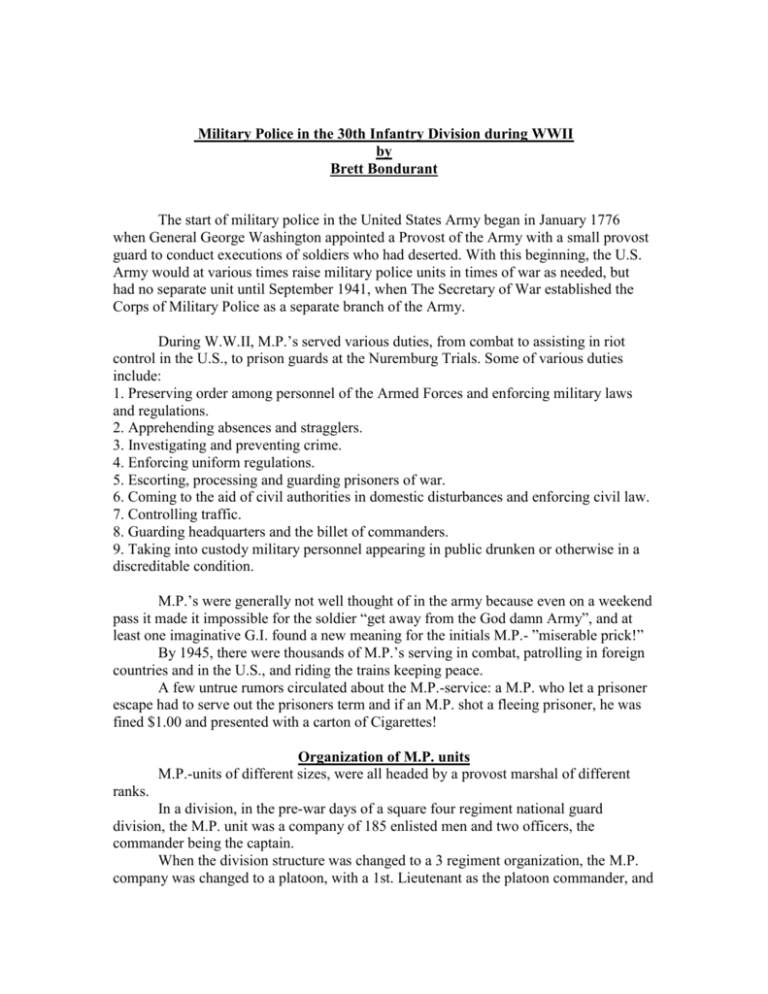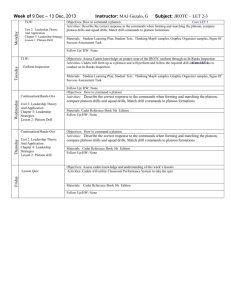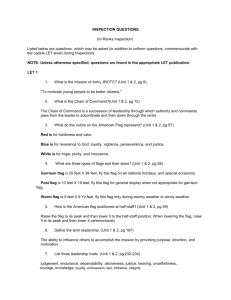Military Police in the 30th Infantry Division during WWII
advertisement

Military Police in the 30th Infantry Division during WWII by Brett Bondurant The start of military police in the United States Army began in January 1776 when General George Washington appointed a Provost of the Army with a small provost guard to conduct executions of soldiers who had deserted. With this beginning, the U.S. Army would at various times raise military police units in times of war as needed, but had no separate unit until September 1941, when The Secretary of War established the Corps of Military Police as a separate branch of the Army. During W.W.II, M.P.’s served various duties, from combat to assisting in riot control in the U.S., to prison guards at the Nuremburg Trials. Some of various duties include: 1. Preserving order among personnel of the Armed Forces and enforcing military laws and regulations. 2. Apprehending absences and stragglers. 3. Investigating and preventing crime. 4. Enforcing uniform regulations. 5. Escorting, processing and guarding prisoners of war. 6. Coming to the aid of civil authorities in domestic disturbances and enforcing civil law. 7. Controlling traffic. 8. Guarding headquarters and the billet of commanders. 9. Taking into custody military personnel appearing in public drunken or otherwise in a discreditable condition. M.P.’s were generally not well thought of in the army because even on a weekend pass it made it impossible for the soldier “get away from the God damn Army”, and at least one imaginative G.I. found a new meaning for the initials M.P.- ”miserable prick!” By 1945, there were thousands of M.P.’s serving in combat, patrolling in foreign countries and in the U.S., and riding the trains keeping peace. A few untrue rumors circulated about the M.P.-service: a M.P. who let a prisoner escape had to serve out the prisoners term and if an M.P. shot a fleeing prisoner, he was fined $1.00 and presented with a carton of Cigarettes! Organization of M.P. units M.P.-units of different sizes, were all headed by a provost marshal of different ranks. In a division, in the pre-war days of a square four regiment national guard division, the M.P. unit was a company of 185 enlisted men and two officers, the commander being the captain. When the division structure was changed to a 3 regiment organization, the M.P. company was changed to a platoon, with a 1st. Lieutenant as the platoon commander, and a 2nd Lieutenant as the executive officer. 70 enlisted men made up the platoon with 1 staff Sgt., 8 Sgts., 1 Tech Sgt., 4th grade, 24 Privates First Class and 30 Privates. The platoon was normally attached to the division headquarters for mess and administration. The Table of Organization and Equipment for the division M.P. platoon allowed for 55 Carbines, 17 Rifles, 1 .45 caliber pistol, 15 jeeps and 3 Dodge Weapons Carriers. The 30th M.P. Platoon The 30th Infantry Division’s W.W.II Military Police unit entered service on September 16, 1940, when the Division was federalized. In the beginning, the M.P.’s were organized along the National guard lines and held the designation of a Company, part of the Special Troops Regiment. It was composed of about 60 men and two officers. The Company Commander was Captain Robert B. Eleazor of Georgia. After moving to Fort Jackson, South Carolina, the Company was brought up to a strength of 185 men. While at Ft. Jackson, the men learned the basics of soldier life. Nightly patrols of nearby Columbia, SC were also conducted which gave the men training in real police work. Participating in division maneuvers in Tennessee and in the Carolina’s gave the men training in traffic control. In February 1942, the Division was triangularized to three infantry regiments and the M.P. Company was cut down to platoon size. Capt. Eleazor was transferred and Lt. William Avery took command. In October 1942 the Division was transferred to Camp Blanding, Florida where the M.P.’s were trained in areas such as blackout driving, security and handling of prisoners, camouflage and ever ending military courtesy and discipline. The M.P.’s went through the same training as infantrymen including map reading, chemical attacks, forced marches, and jungle warfare training. The M.P.’s also went on patrols of local towns, including Jacksonville, Florida where they participated in controlling fights, conducting raids with the local police and enforcing curfew. When the division participated in maneuvers at Camp Forrest, Tennessee in 1943, the M.P.’s did their normal job of traffic control and town patrols as well as escorting movie star Walter Pigeon on a division tour and traveling to Missouri and California to bring back AWOL soldiers. Another interesting job was when they had to arrest the Chief Surgeon of the 119th Infantry Regiment, for having sexual contact with soldiers when he was examining them. In November 1943 when the 30th had moved to Camp Atterbury, Indiana, the military police platoon assisted the local police with an investigation of marijuana use by soldiers. On February 11, 1944, the M.P. platoon, along with the rest of the Division, left Boston, Mass. and boarded ships for the 11 day ocean trip to England. Traveling on board the “SSAT BRAZIL” and the “MS JOHN ERICSSON”, the M.P. Platoon landed with the Division in Liverpool, England on Feb. 22, 1944.They moved first to the South Hampton area, and then to Chichester, Sussex, a distance of about 60 miles from London. While stationed in Sussex, the M.P.’s attended classes in bomb disposal, served as guards for the division payroll, learned how to deal with the expected large amounts of German P.O.W.’s and learned to drive on the left side of the road. They also served as escorts for General’s Eisenhower, Montgomery, Bradley and Hodges as they toured the Division preparing for the invasion of Europe. On June 12 the Platoon set sail for the French coast from the port of South Hampton. Arriving off Normandy on June 14, the men were unloaded onto Omaha Beach around midnight. The Platoon that departed England for Normandy, France consisted of Major John Craig, Division Provost Marshal, 1st Lt. Joseph Yelenosky, Platoon Commander, Lt. J. Nickolai, Assistant Platoon Commander, 2 Staff Sergeants, 7 Sergeants, 6 Corporals, 1 Tech Sergeant 4th Grade, 2 Tech Corporals 5th Grade, 35 Privates First Class, and 27 Privates. Arriving in Isingy, France, a small town near the Division Command Post, the Platoon began to set up for combat duty. Road and motorcycle patrols were organized, as well as traffic control posts. A prisoner of war detail was set up along with a P.O.W. cage near Catz. The men assigned to P.O.W. duty began the important job of processing captured Germans by searching, segregating, feeding, and finally evacuating the men. Supply Sergeant Lucius Hamilton did his best to relieve the infamous K-ration when he took a 3/4 ton truck loaded with German souvenirs to the beachhead to trade for canned meat, fruit, juices etc., for the men. The men continued their normal combat duties and also had to investigate rape cases. The very important job of traffic control came into play as the Division began moving forward. These men had the very dangerous job of directing the huge columns of traffic while under enemy fire. This work took place at various unnamed crossroads and on bridges throughout France, Holland, Beligum, and Germany. Soon after the heroic stand of the Division at Mortain, Cpl. Milton Berk was killed by artillery fire at Juvigny Le Tetre while directing traffic. This was the first of 5 men to be killed in action. As the Division moved toward Paris, the Military Police Platoon had the happier job of providing an escort for actress Dinah Shore and actor Edward G. Robinson, who were entertaining the men of the 30th. When Mr. Robinson requested to talk to a German P.O.W., the men had to put an American officer in German uniform to play the role, as the P.O.W. cages were empty at the time. Such an act was presented for the great actor that he was none the wiser! On September 1, the Division began it’s dash into Belgium. M.P.’s were posted along the route at all the important road junctions and intersections and posted the inverted Divisional “T” sign on trees and poles to mark the route. It became necessary to have extra M.P.’s assigned and engineers were pressed into service to help direct traffic. On September 2, at 1630, the Division entered Belgium. Traveling 180 miles (118 miles in 30 hours), the Division was the first Allied division to enter that country. After moving through Holland, the Division now moved on Germany, smashing through the “Dragon’s Teeth” of the Siegfried Line on October 4, 1944. Once into Germany, the M.P.’s job changed a bit as German civilians were checked, nonfraternizing rules enforced, and looting and straggler patrols took place. The men also served as border guards by setting up a check station on the German boarder near Herzogenrath. Under a large size saying “STOP - BORDER INSPECTION MILITARY POLICE” in English and German, all civilians were stopped and their papers and belongings examined. The M.P. Platoons involvement in the Battle of the Bulge began on December 17, when orders were received for the Division to move south. Marking the route, the men joined the rest of the Division as it headed toward the Spa - Malmedy area to assist the First Army. The march route was very dangerous with the roads clogged with retreating soldiers and civilians and the columns were strafed by German aircraft as well as accidental strafing by Allied planes. Once reaching the Malmedy area, the M.P.’s found the abandoned hospitals, PX’s and supply depots of the First Army and the 99th Division. A guard was placed over the stores and the liquor and wine was made off limits to all troops. Traffic control was a very important and very dangerous duty that the M.P.’s pulled. In addition to the usual hazard of enemy shelling, the men had to endure freezing temperatures, and horrendous road conditions caused by the winter weather. Due to the slippery roads, traffic accidents became very common. Starting on December 23 and ending on December 27, the M.P. Platoon .endured the bombing and strafing of Malmedy by American bombers and fighters. The men helped dig out persons buried by debris, extinguish fires, carry wounded to hospitals, controlled civilians and traffic and prevented looters. Although the men continued to brave the elements while working the roads, other incidents required their attention such as breaking up a boisterous brawl between Division officers at a Christmas Eve party, investigate a drunken officer, and relaxing in the hot sulfur baths at Spa. In early February 1945, the M.P. Platoon assisted the Division as it conducted a secret move, first from Belgium to Aachen, Germany, then from Aachen to Iden, Germany. Shoulder patches and unit vehicle markings were removed, and new code names for road signs and telephone exchanges were set up. Although camouflage procedures were in effect, radios were silent and the Division moved by night, “Axis Sally” broadcasted when the Division conducted its moves. Starting on February 12, 1945, the M.P.’s started a Platoon newsletter to pass out humorous items to the men. Called the OLD HICKORY BRASSARD and finally THE BRASSARD, the newsletter ran at least until March, 12, 1945 with a run of five issues. (I have only seen 5 issues!) On February 23, the M.P. Platoon, using a communications plan especially devised by the 30th Signal Company, played a large role in getting the Division quickly over the Roer River. While directing traffic near Krauthauzen, M.P. Oscar Heinzman was killed by artillery fire. In early March, 1945, the Division moved to the Echt, Holland area to prepare for the important Rhine River crossing. Answering complaints of excessively speeding supply trucks, the men of the M.P. Platoon acted as traffic cops stopping and occasionally arresting speeders and preventing convoys from stopping on the roads. To help assist the 30th M.P.’s of the job of getting troops moved during the river crossing, division M.P.’s of the 35th, 75th, Divisions and XIX Corps were used. On March 24, while at his traffic post, Military Policeman Ernest Solis was killed by artillery fire. The M.P. Platoon crossed the Rhine immediately after the assault troops the direct troop traffic on the other side. Starting on March 31, 1945, the Division began its advance across central Germany. During this advance, William Staehling, a member of General Leland Hobbs’s M.P. detail was killed by artillery fire. Looting had become somewhat a problem in the Division. Colonel Walter Johnson of the 117th Infantry Regiment requested that the M.P.’s guard stores in the city of Hamelin, on the Weser River. Col. Johnson felt that his men were throwing away rations and necessary supplies in order to carry looted items off. On May 8, 1945 the war ended in Europe. For the men of the M.P. Platoon, business was as usual with traffic posts and patrols, investigations and German prisoners to contend with. One unusual investigation involved U.S. soldiers selling “Mickey Mouse” watches to Russian soldiers. The Russians had never seen watches with second hands and were buying them for large sums of money A standoff with the Russians over complaints of Russian troops stealing cattle and food from local German farmers (a violation of the treaty agreement) was settled when a group of M.P.’s , a company of soldiers and a few tanks came into play. The Russians refused to release the goods until guns were leveled at them. Another encounter with the Russians happened when an M.P. patrol, turning around at the border between the American and Russian line entered the Russian zone accidentally. The occupants were detained and the jeep was confiscated. The M.P.’s were later released and the jeep was returned after much discussion. With the war ended, the 30th Division became an occupation unit. The M.P. Platoon kept busy with the investigation of the murder of two German soldiers by Military Government Agents and assisting the medics in preventing the spread of V.D. On November 25, 1945 the 30th Infantry Division, including the 30th Military Police Platoon, was deactivated, and its deeds passed into history. Statistics Covering Period of Combat from the 30th M.P. Platoon 15 June 1944 to 15 May 1945 Killed in Action: -------5 Wounded: --------------17 Stragglers and AWOLs handled by Platoon ---------------------937 Investigations made by Platoon ---------------------------------127 Other cases handled by Platoon ----------------------------------1,402 Prisoners handled by CIC -----------------------------------------2,244 Prisoners of War handled thu Division Enclosures -----------50,774 Approximate number of refuges handled by Platoon ---------51,000 Silver Star --------------1 Purple Hearts---------17 Awards and Decorations Bronze Stars -------40 Oak Leaf Cluster to the Bronze Star ----8 Total Awards ---------66 The M.P. Platoon was also awarded the MERITORIOUS UNIT PLAQUE. Miscellaneous The Military Police marked over 1,500 miles of roads and highways, also patrolled over 50,000 miles of roads and highways for the Division. M.P. Identification, Equipment, Uniforms The 30th M.P.’s wore the same regulation uniform as regular infantry with the exception of the yellow and green piping on the overseas Cap. T Service Cap was occasionally worn while on town patrols. Since M.P.’s enforced uniform regulations, they were required to be sharply dressed and wear the uniform in the prescribed manner. The most identifying insignia of an Military Policeman. was the arm brassard. White “MP” letters on a blue wool band, the brassard was worn on the left arm, just above the elbow. This was held in place by safety pins. The symbol of the military police was the crossed model 1806 Harper’s Ferry .54 caliber Flintlock pistols which was approved in 1922. This was worn as collar insignia and worn on the top left lapel of the service blouse. Brown garrison belts with brown cross belts were worn while on patrol in the U.S. No white gear was ever worn by any 30th M.P.’s during the war. Perhaps the 2nd most noticeable symbol of the military police is the “M.P.” marked helmet. M.P. helmet markings are a great source of confusion and speculation. The first known M.P. helmet markings were gold painted “M.P.” on 1st Division helmets, when they made a beach landing at BaraFranca, Italy, July 1943. The only reference to regulations for M.P. helmets that I have seen comes from Uniform Regulations for the 8th Infantry Division, dated May 4, 1944. These regulations state: “Military Police personnel will wear the markings of the size and description described in Sec. II, Adm Cir 88, Hq SOS ETOUSA, 26 November 1943. The Steel helmet and liner of all Military Police personnel will be marked on the front with the letters “MP” in white paint (the letters ”MP” will be spaced one and one half inched apart on the helmet of MP officers so as to allow space for insignia of rank.) All Military Police helmets and helmet liners will be marked with a one inch stripe, painted in yellow lusterless paint, encircling the helmet or helmet liner.” (Anyone know where I can get a copy of this ETO regulation???) Late in the war, units also began to mark their M.P. helmets with their division insignia. This varied from unit to unit. In the 30th the insignia was painted just above the “MP” .I questioned a few 30th M.P. Platoon veterans concerning their helmets A few remembered the white MP letter on the front, one said the helmet just had a yellow band. A few described the regulation white lettering with the yellow band. Mr. Lucius Hamilton stated that the helmets were painted before leaving England and were repainted in the field. Mr. Carl Nunemaker wrote that some, if not all the helmets had the Division insignia painted on them by the end of the war. He painted them on in the field. In the March 12th issue of THE BRASSARD, it is stated “To look your best, Smoky Hamilton suggests that washing your helmets will help keep the new paint jobs with insignia in topnotch shape - like the Stetson home.” He also stated that at the end of the war he was asked by the Division Provost Marshal to paint some white helmets/liners for the Command Post M.P.’s. General Hobbs saw one of them and asked “Who in the hell is that M.P. out there?” When told it was one of his , he was told to take it off. I sent a questionnaire out to the 30th M.P. Platoon members who are members of the 30th Infantry Division Association. I have received nine replies back. Among the questioned asked, one was What were the positives and negatives about being an MP? Mr. Lucius Hamilton wrote “We were proud to be an MP in the position to help soldiers lost, stragglers and those wounded trying to find a first aid station. Directing traffic in the right direction as well as helping civilians being evacuated.” Mr. Carl Nunemaker wrote that “It kept me from being cannon fodder on the front, although we were close to it most of the time.” Another plus mentioned was that it was usually 4 to a post and there was no direct contact with NCO’s or officers. He also mentioned that most posts were crossroads that drew artillery fire and there was also the danger of being shot or run over at night. Mr. Edward Devlin wrote that “If you liked being in the Army, you liked being an M.P., if you hated to be in the Army, you hated being an M.P.” Mr. Harvey Nelson wrote “It was a job that had to be done and we did the best we knew how to.” Mr. Elton Smith remembers just after the war providing a motorcycle escort for General Eisenhower and turning the bike over in some loose gravel. He stated that he wasn’t seen and “Thank the Lord for that!” I would like to thank all of the 30th Military Police Platoon men who served in the war and the following veterans who answered the questionnaire: Claude Poland, Joseph Cadwell, Edward Devlin, W.S. Gann, Harvey Nelson, Carl Nunemaker, Elton Smith, Lucius Hamilton and the widow of J.E. Williams.




